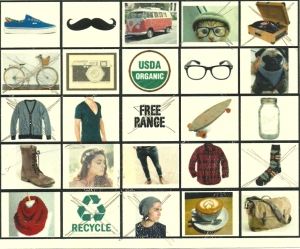Our family is fortunate to attend a really creative church. On a recent high school retreat, my son came home with this bingo board (see above). My social language brain lit up like a Christmas tree! Hipster bingo was played as part of a discussion on what people perceive others to be based on what they see. In the age of ever-present social media, right or wrong, labels and perceptions often define this generation. While the social commentary on what a hipster is (or isn’t) is interesting, I thought of how this could be used in a variety of ways to connect the clues we see in others to make smart guesses about who they are.
Students with social communication impairments often miss the big picture. They may notice individual details, but to pull those details together and make a prediction from that information is a huge leap. A smart and creative colleague of mine was working with a young lady with ASD and showed her an advertisement of a young woman rollerblading in a park. When she asked the student what could she guess about the person in the picture, the student commented that she must be a mom about 35. When she was asked about the specific details of the picture, the student could identify them appropriately but kept referencing a mom with kids but not the target idea of exercising or being healthy. Puzzled by this response, the therapist probed further and soon realized the student was making guesses based on what she knew of her own mom, not on what she saw in the picture (a healthy, exercising, young woman). She was missing the forest for the trees.
These connecting ideas are difficult and weakness with this translates academically into students having a hard time summarizing, identifying main ideas, predicting and being able to talk about a ‘big picture’ idea in literature/history/science in the classroom. It also causes kids to misread social situations with their peers and adults. Here are a couple of ideas to work on this skill:
You can use a concrete visual (this would also be great with cause and effect and turn taking in conversation too), for example links of paper: 
The student could look at a picture like this:
+ identify important clues on each link of the chain: basketball, doctor, sports jersey, bandage on arm, sad face on boy = smart guess?
CONCLUSION he was hurt playing ball
Another concrete option is to look at a picture together and talk about what information you know from what you see. Then cut the picture into 4-6 puzzle pieces and write down an important detail you talked about on each piece. Next, your group could make a guess about what the big idea/theme will be when you put them together. Assemble the clues and see if they were right! If not, it’s a great way to review what they misinterpreted and talk through the process together.
Last but not least, the bingo board is a way to work on making a smart guess about a big picture idea. There are several bingo boards here on Pinterest that allow you to create your own. I have found Nerd bingo, selfie bingo and Macbeth bingo on this site! You could create one for your students with pictures of how they would like to be perceived by their peers (happy, smart, athletic, kind…) or with character traits/nonverbals for how you wouldn’t want to be perceived (angry, sneaky, selfish…). For your older students, you can use it for themes in literature, for example the key theme of hate in Romeo and Juliet and how each character was affected by or contributed to it.
That’s my big idea today social language hipsters, what’s yours??





